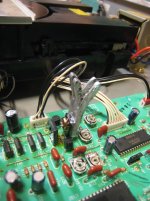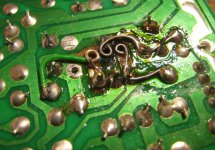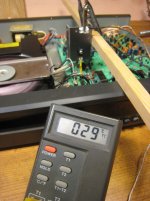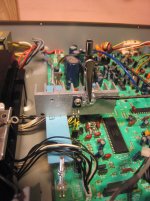Hi!
I`m having a literally burning problem with my NAD Monitor Series 5K player: one of the two transistors controlling focus coil gets very hot - 75-80C with heatsink (!), without heatsink it went as hot as 150C before I turned the player off.
I know there`s a known problem with this player regarding transistors driving focus coil overheating to the point of damaging solder joints, there`s even a service note describing the problem and suggesting replacing said transistors with physically bigger ones for better heat dissipation. I did so when the player started skipping (after ruling out pickup wear or damage) along with replacing bad capacitors (the real cause of skipping). The player works great now, but that one transistor still gets scorching hot and I don`t like that.
My question: is this normal for this player? I Can`t tell without other unit to compare. I got the service manual, run adjustment procedures, all seem to be OK... anyone with NAD 5000 willing to open his/her player and measure (or feel with a fingertip - but careful!) the temperature of Q102 and Q103? Or maybe someone already knows what`s going on? Please help!
- but careful!) the temperature of Q102 and Q103? Or maybe someone already knows what`s going on? Please help!
Thanks in advance!
I`m having a literally burning problem with my NAD Monitor Series 5K player: one of the two transistors controlling focus coil gets very hot - 75-80C with heatsink (!), without heatsink it went as hot as 150C before I turned the player off.
I know there`s a known problem with this player regarding transistors driving focus coil overheating to the point of damaging solder joints, there`s even a service note describing the problem and suggesting replacing said transistors with physically bigger ones for better heat dissipation. I did so when the player started skipping (after ruling out pickup wear or damage) along with replacing bad capacitors (the real cause of skipping). The player works great now, but that one transistor still gets scorching hot and I don`t like that.
My question: is this normal for this player? I Can`t tell without other unit to compare. I got the service manual, run adjustment procedures, all seem to be OK... anyone with NAD 5000 willing to open his/her player and measure (or feel with a fingertip
Thanks in advance!
The coil current (focus Q102,103 and tracking Q104,105) runs through these transistors. The fact that Q102 and 103 are getting really hot suggest an incorrect position of the CD, with reference to pickup lens; the vertical distance between the pickup lens and the CD is either too high, or too low.
With the original transistors, you were hitting the saturation point - the tracking was skipping because the lens couldn't focus (compensate for the positional error) & read the CD.
With the higher current transistors, more current can get through, so the tracking is "just" okay. If the positioning of the lens / CD gets out of the wack bit more, the next to go are a fusible "IC's" IP101 and 102 and/or you'll burn the focus coil. This will also depend on a type of transistors you put in.
I'd get a CD that is packed with music tracks to the max, play the last track (this will force the pickup to the outer edge of the CD, and then visually observe the lens position while tracking - the lens should look like it's resting in its "normal" position, i.e. like when the player is off, with a minimal movements up AND down.
If it jumps too much up and stays up, or it's shoved down and stays down, adjust the geometry of the CD spindle motor to make sure the focus servo will not have any constant positive or negative high current bias running through Q102, 103)
With the original transistors, you were hitting the saturation point - the tracking was skipping because the lens couldn't focus (compensate for the positional error) & read the CD.
With the higher current transistors, more current can get through, so the tracking is "just" okay. If the positioning of the lens / CD gets out of the wack bit more, the next to go are a fusible "IC's" IP101 and 102 and/or you'll burn the focus coil. This will also depend on a type of transistors you put in.
I'd get a CD that is packed with music tracks to the max, play the last track (this will force the pickup to the outer edge of the CD, and then visually observe the lens position while tracking - the lens should look like it's resting in its "normal" position, i.e. like when the player is off, with a minimal movements up AND down.
If it jumps too much up and stays up, or it's shoved down and stays down, adjust the geometry of the CD spindle motor to make sure the focus servo will not have any constant positive or negative high current bias running through Q102, 103)
Last edited:
Hi Extreme_Boky, thanks for the reply!
Unfortunately, I don`t think this is the case.
NAD 5000 uses a Sony KSS-210A pickup, where the resting position of the lens (with power absent) is the lowest position it can travel to. Looks like the lens is pushed up by the focus coil, and pulled down by a spring. So the q102 is always on and doing the heavy lifting, I guess.
I tried lowering the platter, but the plastic shell of the pickup got in the way. I managed to lower it a bit anyway, now the Q102 heats up to about 70C, a slight improvement over 78-79C before. Can`t lower it more without risking jamming the pickup against the platter.
Maybe there is some kind of design flaw on NAD`s part?
Thanks again!
Unfortunately, I don`t think this is the case.
NAD 5000 uses a Sony KSS-210A pickup, where the resting position of the lens (with power absent) is the lowest position it can travel to. Looks like the lens is pushed up by the focus coil, and pulled down by a spring. So the q102 is always on and doing the heavy lifting, I guess.
I tried lowering the platter, but the plastic shell of the pickup got in the way. I managed to lower it a bit anyway, now the Q102 heats up to about 70C, a slight improvement over 78-79C before. Can`t lower it more without risking jamming the pickup against the platter.
Maybe there is some kind of design flaw on NAD`s part?
Thanks again!
Then use a TO3 transistor (joke)...
...It would be interesting to know what the Q102 current is... maybe place a resistor in a collector-emitter path, and measure the voltage drop.
It seems that's how NAD engineered the CD player, to accommodate the Sony mechanism... replacing the original transistor with a higher dissipation one seems like the only choice.
...It would be interesting to know what the Q102 current is... maybe place a resistor in a collector-emitter path, and measure the voltage drop.
It seems that's how NAD engineered the CD player, to accommodate the Sony mechanism... replacing the original transistor with a higher dissipation one seems like the only choice.
Sorry for delay, that was a busy week.
From my crude measurements it looks like the transistor takes up to 1.5W, with 0.7W-1W typically.
Since there`s no way to give it a sensible heatsink while it`s mounted on the pcb, I decided to lift the transistor above the board, attached it to a temporary heatsink fixed to a piece of wood laying on the player and put on a cd. With proper cooling the transistor was sitting comfortably at 29C. I used pieces of 4mm threaded rod, some nuts and a piece of acrylic as a support for the final (I believe) heatsink. It`s still a work in progress and I`m testing the player, but right now the transistor does not go above 44C with top cover on. I can live with that.
I`ll attach a couple photos so you can see things I do to keep my NAD going: on the first one is my first attempt at cooling, with that piece of aluminium the transistor was at 75-80C. See these 4 dinky transistors on the leftt? The original focus transistors were the same. I`m amazed they did not combust. Second photo: I had to patch up the traces and pads since I lifted them by accident. They probably were weak from the constant heat, all it took was a delicate nudge. Meh. Third photo: test heatsink and thermometer readout, fourth: the final (I think) arrangment. The leads need shortening, but mostly for cosmetic purposes, their length does not seem to affect the operation.
That`s it for now, thanks for the replies!
From my crude measurements it looks like the transistor takes up to 1.5W, with 0.7W-1W typically.
Since there`s no way to give it a sensible heatsink while it`s mounted on the pcb, I decided to lift the transistor above the board, attached it to a temporary heatsink fixed to a piece of wood laying on the player and put on a cd. With proper cooling the transistor was sitting comfortably at 29C. I used pieces of 4mm threaded rod, some nuts and a piece of acrylic as a support for the final (I believe) heatsink. It`s still a work in progress and I`m testing the player, but right now the transistor does not go above 44C with top cover on. I can live with that.
I`ll attach a couple photos so you can see things I do to keep my NAD going: on the first one is my first attempt at cooling, with that piece of aluminium the transistor was at 75-80C. See these 4 dinky transistors on the leftt? The original focus transistors were the same. I`m amazed they did not combust. Second photo: I had to patch up the traces and pads since I lifted them by accident. They probably were weak from the constant heat, all it took was a delicate nudge. Meh. Third photo: test heatsink and thermometer readout, fourth: the final (I think) arrangment. The leads need shortening, but mostly for cosmetic purposes, their length does not seem to affect the operation.
That`s it for now, thanks for the replies!
Attachments
Interesting idea, but I think it would be rather hard to implement with not much to gain, if at all. I`ll tidy up the existing set-up, put the cover on and no one will know 
By the way, it turned out that my meddling with the position of the platter did not do much good, quite contrary: the cd started skipping occasionally. After a couple unsuccesful attempts to reposition it I came up with a simple rig that allowed me to pull the platter up a fraction of mm at a time, pushed the platter down as far as it could go, then pulled it a tiny bit up at a time until I found the sweet spot. The NAD works nice now, laser replacement I bought is still in its box, case closed, I hope
By the way, it turned out that my meddling with the position of the platter did not do much good, quite contrary: the cd started skipping occasionally. After a couple unsuccesful attempts to reposition it I came up with a simple rig that allowed me to pull the platter up a fraction of mm at a time, pushed the platter down as far as it could go, then pulled it a tiny bit up at a time until I found the sweet spot. The NAD works nice now, laser replacement I bought is still in its box, case closed, I hope
- Home
- Source & Line
- Digital Source
- NAD Monitor Series 5000 - hot focus servo



